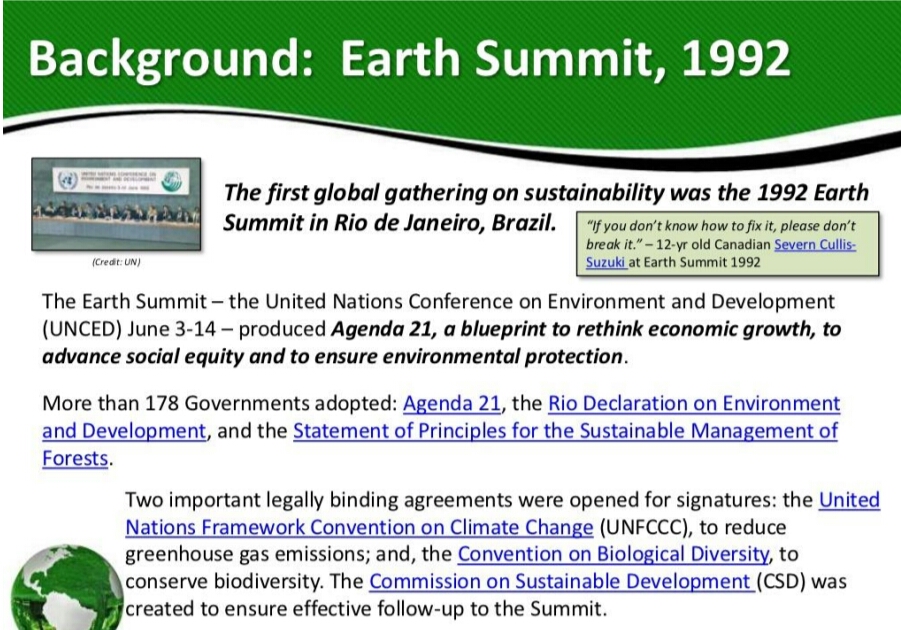Rio Earth Summit or UNCED
The United Nations Conference on Environment and Development (UNCED), also known as the Rio Earth Summit, the Rio Summit, the Rio Conference, and the Earth Summit, was a major United Nations conference held in Rio de Janeiro from 3 to 14 June 1992.
More than 100 heads of states met in RIO DE JANEIRO in Brazil.
Rio Earth Summit was created as a response for Member States to cooperate together internationally on development issues after the Cold War.
Due to conflict relating to sustainability being too big for individual member states to handle,Rio Earth Summit was held as a platform for other Member States to collaborate.
Since the creation, many others in the field of sustainability show a similar development to the issues discussed in these conferences, including non-governmental organizations (NGOs).
In 2012, the United Nations Conference on Sustainable Development was also held in Rio, and is also commonly called Rio+20 or Rio Earth Summit 2012. It was held from 13 to 22 June.
The issues addressed included:
1. systematic scrutiny of patterns of production — particularly the production of toxic components, such as lead in gasoline, or poisonous waste including radioactive chemicals
2. alternative sources of energy to replace the use of fossil fuels which delegates linked to global climate change
3. new reliance on public transportation systems in order to reduce vehicle emissions, congestion in cities and the health problems caused by pollutedair and smoke
4. the growing usage and limited supply of water.

An important achievement of the summit was an agreement on the Climate Change Convention which in turn led to the Kyoto Protocol and the Paris Agreement.
Another agreement was to "not to carry out any activities on the lands of indigenous peoples that would cause environmental degradation or that would be culturally inappropriate".
The Convention on Biological Diversity was opened for signature at the Earth Summit, and made a start towards redefinition of measures that did not inherently encourage destruction of natural ecoregions and so-called uneconomic growth.
The Earth Summit resulted in the following documents:
1. Rio Declaration on Environment and Development
2. Agenda 21
Moreover, important legally binding agreements (Rio Convention) were opened for signature:
1. Convention on Biological Diversity
2. Framework Convention on Climate Change (UNFCCC)
3. United Nations Convention to Combat Desertification
In order to ensure compliance to the agreements at Rio (particularly the Rio Declaration on Environment and Development and Agenda 21), delegates to the Earth Summit established the Commission on Sustainable Development (CSD).
• In 2013, the CSD was replaced by the High-level Political Forum on Sustainable Development that meets every year as part of the ECOSOC meetings, and every fourth year as part of the General Assembly meetings.
Critics point out that many of the agreements made in Rio have not been realized regarding such fundamental issues as fighting poverty and cleaning up the environment.





0 Comments
Feel free to ask any doubt in comment section